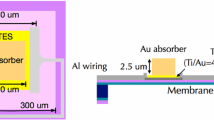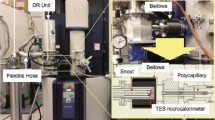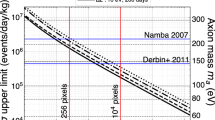Abstract
We herein report a concept study of a transition edge sensor (TES) X-ray microcalorimeter array with two different thickness absorbers. We developed an energy-dispersive X-ray spectroscope (EDS) with a 64-pixel TES array and installed it on a scanning transmission electron microscope (STEM) for material analysis. One of the key applications of the proposed system is the microanalysis of astromaterials, for which the relative abundance of light elements such as boron, carbon, and oxygen against silicon are crucial. However, the line sensitivity below \(\sim\) 500 eV for the our STEM TES EDS system was not enough to detect the X-ray from light elements because of the relatively high continuum emission and low detection efficiency, which occurs due to the X-ray window and the optical blocking filters. A simple solution to increase line sensitivity at low energy is the adoption of thin X-ray absorbers that leads to an improvement in the energy resolution. However, doing so causes the sensitivity to decrease for high energy lines. Utilizing the spot-size dependence of the polycapillary X-ray optics on energy, which are used in the STEM TES EDS system, we studied a design in which thin absorbers are distributed on the outer area of detector. We optimized the design using the raytracing analysis of optics. A thin (300 nm) absorber is placed on the 52 outer pixels, while a thick (3.5 \(\upmu\)m) absorber is placed on the central 12 pixels. The thin pixels detect approximately 50–60% of the total counts in 0.1–2 keV, while the central thick pixels detect approximately 50–80% of the total counts in 2–10 keV. We also demonstrated the fabrication process of two-thickness absorber arrays.
Similar content being viewed by others
1 Introduction
The formation and evolution of the solar system is one of the most important research subjects in astrophysics and planetary science. Astromaterials are known to contain information about the early phase of our solar system. Studies on astromaterials, such as sample-return missions (e.g., HAYABUSA [1, 2], OSIRIS-REX [3]), provide valuable insights into the formation and evolution of our solar system. Astromaterials include several elements like silicon, oxygen, carbon, and boron, and some sub-microscale structures, in both small and large quantities. The relative abundance of light elements such as boron, carbon, and oxygen against silicon provides us with information regarding the solar wind effect [4] and also about the origin of water on earth [5]. One of the most useful tools is the energy-dispersive X-ray spectroscopy (EDS) in combination with a scanning transmission electron microscope (STEM), which can be used to analyze the astromaterials on a sub-micrometer scale. By applying the aforementioned method, the abundance of an element in terms of the level of a few percentages in sub-micron scale spatial resolution can be determined. The conventional semiconductor-based EDS system is sometimes insufficient for resolving emission lines at closely adjacent energies. In order to improve the energy resolution under a high counting rate in a wide energy band, a transition edge sensor (TES) X-ray microcalorimeter [6] is good solution. We developed a 64-pixel TES X-ray microcalorimeter array for EDS’s detector [7]. The TES chip size which is 5.2 mm square is strongly constrained by the geometry the STEM and a detector head at the 100 mK refrigerator. The detector head was adopted to mount the TES chip and SQUID (superconducting quantum interference device) array amplifier comprising a 12-mm \(\times\) 12-mm \(\times\) 10-cm rod with a 30-mm cube at the bottom of the rod, which was integrally machined from a single copper block [8]. An X-ray event from the specimen is focused to the TES chip by the polycapillary X-ray optics with a focusing size of roughly 3 mm\(^2\). Thus, to pack the 8 \(\times\) 8 TES array onto the 3-mm\(^2\) area, we set the TES size to be 180 \(\upmu\)m square and attached a 120 \(\upmu\)m square gold absorber to the TES pixel [9]. The transition temperature \(T_\mathrm{c}\) was 160 mK, and the rise time constant and the fall time constant were \(\sim\) 1 \(\upmu\)s and \(\sim\) 70 \(\upmu\)s, respectively. We assembled the TES with the STEM-EDS and evaluated the energy resolution of 10 eV (FWHM) at Al Ka line (= 1.49 keV) under a counting rate of 4.5 kcps with a 17-pixel operation. In the low count rate of 100 cps, this system was verified to have an energy resolution of 7 eV (FWHM) at MnKa line (= 5.9 keV) [8]. Further, we confirmed that this system was improved in terms of its quantitative analysis with systematic errors of less than 1% [10]. However, an intensity in the low energy X-ray band was strongly limited by the X-ray window and the optical blocking filters.
2 Detection Limit in the Low Energy Band
Low energy bands in boron (= 183 eV), carbon (= 281 eV) and oxygen (= 523 eV) provide us with useful information about our solar system. By considering only statistical uncertainty, the detection limit is simply equal to the signal-to-noise ratio (SNR) and can be expressed as follows.
where Z is the confidence level of unit \(\sigma\), S is the number of incident photons of a target element (counts), b is the background level (counts/eV), \(\Delta E\) is the energy resolution expressed as \(\Delta E\sim \sqrt{k_\mathrm{B}T_\mathrm{c}^{2}C}\), and \(\varepsilon\) is the fudge factor. b and \(\varepsilon\) are experimentally provided in 13 (counts/eV) and 1, respectively. In our system, the 3\(\sigma\) detection limit is calculated to be roughly 45 (wt%: weight percent) at boron by Eq. (1), because of the background level, absorption of the optical blocking filter or X-ray window. A simple solution to increase the line sensitivity at low energy bands is to adopt TES with a lower heat capacity C and lower \(T_\mathrm{c}\), such that the energy resolution can be improved. However, a lower C and a lower \(T_\mathrm{c}\) can cause the energy range to become narrow; this is because the energy range is equal to the energy saturation which can be expressed as \(E_\mathrm{sat}\propto CT_\mathrm{c}\). Therefore, we investigated a design where two different types of the TES pixels can be set on a single device in order to cover the low and high energy bands.
3 Conceptual Design for Covering Low and High Energy Bands
In the STEM TES EDS system, we used the polycapillary X-ray optics to collect the X-rays from the specimen by increasing the solid angle. The distribution of X-rays on the TES chip was dependent on the energy of the incident X-rays into the polycapillary optics. We investigated the focal spot sizes (FWHM:full width at half maximum) for several incident X-ray energies on the TES chip by the experiment (Fig. 1a). The spread of the low energy X-rays on the TES chip is greater than the spread of the high energy X-rays. We also performed raytracing analysis with the polycapillary X-ray optics and simulated its X-ray broadening on the TES chip for boron (= 183 eV), silicon (= 1.7 keV), titanium (= 4.5 keV), iron (= 6.4 keV), and copper (= 8.4 keV) using the model proposed by Takano et al. [11], as shown in Fig. 1c, d. Figure 1b shows the ratio of the incident count at the central 12 pixels or the peripheral 52 pixels to the total count. The results of the low energy band simulation show that the peripheral 52 pixels, excluding the central 12 pixels, occupied approximately 50–60% of the total counts in the range of 0.1–2 keV (orange line of Fig. 1b). On the other hand, the results of the high energy band simulation show that the central 12 pixels occupied approximately 50–80% of the total counts in the range of 2–10 keV (blue line of Fig. 1b). Based on the results of these simulations, we suggest a design consisting of 12 pixels for the centroidal area to cover the high energy band and 52 pixels for the peripheral area to cover the low energy band. To satisfy the requirement of high energy resolution in the low energy band, we need to design the TES pixels for the low C and low \(T_\mathrm{c}\); however, \(T_\mathrm{c}\) is limited in more 120 mK by the cooling power of the refrigerator. Thus, we set \(T_\mathrm{c}\) at 120 mK and control only the C of the TES pixels. In order to control the C of the TES pixels, two methods are suggested: controlling the pixel size and controlling the absorber thickness of the TES. We suggest controlling the C by changing the absorber thickness of the TES because it is necessary to increase the number of TES pixels by changing the pixel sizes in order to cover the same effective area as that outside the region of interest. The requirements to improve the detection limit by more than 10% (from Eq. 1) in the low energy band include a saturation energy of more than 1.78 keV of Si K\(\upalpha\), an energy resolution of less than 2 eV, and a quantum efficiency of more than 80% in the range of 0.1–2 keV. To satisfy these requirements in the low energy band, we optimized the absorber thickness and set it to 300 nm; on the other hand, we set the absorber thickness to 3.5 \(\upmu\)m in the high energy band.
Experiment result of the focal spot size and simulation results by polycapillary X-ray optics. a The focal spot size at FWHM (mm) of the polycapillary X-ray optics versus an incident X-ray photon energy. A red line is the first-order polynomial function by fitting to data. b Incident photon-to-total counts ratio versus the incident X-ray energy (keV). The focal spot size at FWHM (mm) of upper x axis is converted from the incident X-ray energy using relation of a. The blue and orange lines are the incident counts-to-total counts ratio of centroid 12 pixels and outside 52 pixels, respectively. c, d The counts map on 64-pixel TES chip, respectively, at 183 eV and 8.4 keV by the raytracing (Color figure online)
4 Fabrication Process and Results
We demonstrated the fabrication of the TES with different thickness absorber. In the test device, we located the eight TESs with the thinner absorbers at a radius 1 mm where they occupy approximately 20% of the total count in Fig. 2 left. We used a silicon wafer of 300-\(\upmu\)m thickness, and SiO\(_{2}\) and SiN\(_{x}\) are deposited both sides which thicknesses are 0.5 \(\upmu\)m and 1 \(\upmu\)m, respectively. The TES comprises a bilayer of Ti and Au, in which the thicknesses are, respectively, 40 nm and 110 nm, and the layers were deposited on SiN\(_{x}\) by DC magnetron sputtering. The Al wiring for the TES readout electrode was deposited by RF sputtering and was formed by the etching and liftoff processes [9] (Fig. 2, process-1). The gold absorbers were deposited with an electron beam (EB) evaporation apparatus, and the absorber’s pattern was formed by the liftoff process. Two types of absorbers of different thickness values were formed on two parts. In order to properly form the photoresist pattern for the high energy band, we first formed the photoresist pattern for the low energy band because the absorber thickness is lower: 300 nm (Fig. 2, process-2). For the low energy bands, we formed the 300-nm-thick absorber at the deposition rate of approximately 0.8 nm/s, and the total deposition time was 6 min (Fig. 2, process-3). Second, for the high energy band, we formed the photoresist pattern and deposited the absorber with a thickness of 3.3 \(\upmu\)m at the deposition rate of 1.6 nm/s for a total time of 34 min (Fig. 2 processes 4 and 5). The absorber was formed by the liftoff process; thus, the thickness and shape were defined by the photoresist. In order to realize a thickness of 7 \(\upmu\)m and inversely tapered shape, we used an image reversal resist “AZ5200NJ.” After the absorber formation process (Fig. 2, process-6), we set the resist for protection of the TES array and formed a membrane via deep reactive ion etching, thus completing the 64-pixel array TES chip fabrication. The results of the fabricated TES chip are shown in Fig. 3 right, and we confirmed that the absorber thickness was as designed (Fig. 4).
Location map of absorber thickness and fabricated test TES device. Left shows the location of the thick absorber of 3.3 \(\upmu\)m and thin absorber of 300 nm. Location of thin (300 nm) absorbers are painted in red. The thick absorber of 3.3 \(\upmu\)m are located on white pixel area, and pixels painted in gray are disconnected the readout system. Dash circle is distance (radius is about 1 mm) from center of chip to thin absorber. Right is an optical microscope image of fabricated test device (Color figure online)
Optical microscope image of the TES X-ray microcalorimeter pixel of Fig. 3 right. Top left shows the TES pixel of the 3.3-\(\upmu\)m-thick absorber. Top right shows the TES pixel of 300-nm-thick absorber. Bottom left shows the absorber thickness of TES for the high energy bands. Bottom right shows the absorber thickness of TES for the low energy bands. This thickness was measured on the red dash line of the top by a stylus-type profiler (Color figure online)
5 Summary
We have been developing the TES microcalorimeter for the STEM-EDS system in wide energy band from 0.1 to 15 keV for the quantitative analysis of astromaterials. We developed the TES for the energy band of 1.5–6.0 keV, and the energy resolutions in the energy range were 10 eV under high and low count rate. In order to improve the detection limit of the X-ray photons below 1 keV, we designed the TES with thinner absorber and reduced the heat capacity. Based on the simulation results, we found the spread of low energy X-ray is larger than that of high energy, and we located the thinner absorber on the out side and thicker absorber on the centroid to one TES chip. The TES with two different thickness absorbers was fabricated by deposition gold twice. We will install the TES to STEM-EDS and confirm the energy resolution and count rate.
References
F. Kazuhisa, Y. Masa-Yuki, A. Shinsuke, I. Yoshiaki, I. Ohmi, K. Yoshihiro, H. Yoshihiro, F. Muneyoshi, T. Hiroki, S. Toshiyuki, Y. Toshifumi, K. Hirohisa, S. Michael, U. Masayoshi, S. Yasuo, S. Masaharu, PASJ 63, 961–969 (2011). https://doi.org/10.1093/pasj/63.5.961
S. Watanabe et al., Science (2019). https://doi.org/10.1126/science.aav8032
D.S. Lauretta et al., Space Sci. Rev. 212, 925–984 (2017). https://doi.org/10.1007/s11214-017-0405-1
W. Fujiya, P. Hoppe, U. Ott, Meteorit. Planet. Sci. 51, 1721–1729 (2016). https://doi.org/10.1111/maps.12686
C. Le Guillou, A. Brearley, Relationships between organics, water and early stages of aqueous alteration in the pristine CR3.0 chondrite MET 00426. Geochim. Cosmochim. Acta 131, 344–367 (2014)
K.D. Irwin, G.C. Hilton, Cryog. Part. Detect. (2005). https://doi.org/10.1007/10933596_3
K. Maehata, T. Hara, K. Mitsuda, M. Hidaka, K. Tanaka, Y. Yamanaka, J. Low Temp. Phys. (2015). https://doi.org/10.1007/s10909-015-1361-3
T. Hayashi, H. Muramatsu, K. Maehisa, N.Y. Yamasaki, K. Mitsuda, A. Takano, S. Yoshimoto, K. Maehata, M. Hidaka, H. Yamamori, T. Hara, J. Low Temp. Phys. (2018). https://doi.org/10.1007/s10909-018-2013-1
H. Muramatsu, K. Nagayoshi, T. Hayashi, K. Sakai, K. Mitsuda, N.Y. Yamasaki, K. Maehata, T. Hara, J. Low Temp. Phys. (2016). https://doi.org/10.1007/s10909-016-1547-3
T. Hayashi, H. Muramatsu, K. Maehisa, N.Y. Yamasaki, K. Mitsuda, K. Maehata, T. Hara, IEEE Trans. Appl. Supercond. (2019). https://doi.org/10.1109/TASC.2019.2902304
A. Takano, K. Maehata, N. Iyomoto, T. Hara, K. Mitsuda, N. Yamasaki, K. Tanaka, IEEE Trans. Nucl. Sci. (2018). https://doi.org/10.1109/TNS.2017.2786703
Acknowledgements
This work was partly supported by SENTAN, Japan Science and Technology Agency (JST) and JSPS Challenging Research (Exploratory) 18K18794.
Author information
Authors and Affiliations
Corresponding author
Additional information
Publisher's Note
Springer Nature remains neutral with regard to jurisdictional claims in published maps and institutional affiliations.
Rights and permissions
Open Access This article is licensed under a Creative Commons Attribution 4.0 International License, which permits use, sharing, adaptation, distribution and reproduction in any medium or format, as long as you give appropriate credit to the original author(s) and the source, provide a link to the Creative Commons licence, and indicate if changes were made. The images or other third party material in this article are included in the article's Creative Commons licence, unless indicated otherwise in a credit line to the material. If material is not included in the article's Creative Commons licence and your intended use is not permitted by statutory regulation or exceeds the permitted use, you will need to obtain permission directly from the copyright holder. To view a copy of this licence, visit http://creativecommons.org/licenses/by/4.0/.
About this article
Cite this article
Hayashi, T., Muramatsu, H., Konno, R. et al. A Concept Design of TES X-ray Microcalorimeter Array with Different Thickness Absorber Toward the Observation from 50 eV to 15 keV for STEM-EDS. J Low Temp Phys 199, 908–915 (2020). https://doi.org/10.1007/s10909-019-02326-z
Received:
Accepted:
Published:
Issue Date:
DOI: https://doi.org/10.1007/s10909-019-02326-z








